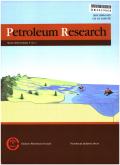Comparative organic geochemistry of shale deposits of northern Appalachian Basin
IF 4
Q1 Earth and Planetary Sciences
引用次数: 0
Abstract
The organic-rich black shales in the Appalachian basin are a vital producer of natural gas. In this study, we present new multiproxy geochemical data from the Ordovician and Devonian black shales in New York (NY) and Pennsylvania (PA). The samples include outcrop samples collected in NY (Utica Group and Marcellus Formation) and core samples from PA (Marcellus Formation, Skaneateles Formation, and Genesee Group). We combined organic geochemical data (% total organic carbon or %TOC, δ13Corg, C/N ratio, and lipid n-alkane distribution) with trace element (TE) data to identify the organic matter (OM) sources and depositional conditions. The TE analysis data shows that water conditions were variable during the deposition of these black shales, fluctuating between oxic and dysoxic conditions with occasional anoxia. There was probably a change from an open water condition (Co∗Mn = 0.2) during the deposition of the Flat Creek Formation to a more restricted exchange later during the deposition of the Indian Castle Formation (Co∗Mn = 2.9) in the Ordovician. Basin circulation likely remained restricted during the deposition of the Devonian black shales (Co∗Mn ranges from 0.4 to 1.3). Based on δ13Corg values (−32.9‰ and −29.6‰) that are more depleted than marine OM δ13Corg, C/N ratios (11.2 and 9.2) higher than marine OM, and the presence of longer chain n-alkanes in the range of C25 to C33, we suggest that bryophytes were possibly a significant organic source to the Ordovician Utica Group in NY. The kerogen type in Utica Group samples is type III, mostly terrestrial OM. The Devonian NY and PA samples show mostly bimodal distributions. In some samples, a secondary, though sometimes dominant, shorter chain peak in the range of C14 to C20 is present, in addition to the long chain peak. We suggest the bimodal n-alkane distribution signifies a mixed OM source consisting of terrestrial and marine contributions with differing degrees of thermal maturation compared to the samples with a unimodal distribution. Our results suggest that samples from the NY Marcellus Group are composed of type III kerogen, while samples from the PA Marcellus Formation, Skaneateles Formation, and Genesee Group contain both type II and type III kerogens.
阿巴拉契亚盆地北部页岩矿床有机地球化学对比研究
阿巴拉契亚盆地富含有机物的黑色页岩是天然气的重要产地。在这项研究中,我们提出了来自纽约(NY)和宾夕法尼亚州(PA)奥陶系和泥盆系黑色页岩的新的多代理地球化学数据。样品包括在NY (Utica组和Marcellus组)采集的露头样品和PA (Marcellus组、Skaneateles组和Genesee组)的岩心样品。结合有机地球化学数据(总有机碳%或TOC %、δ13Corg、C/N比值、脂质正构烷烃分布)和微量元素(TE)数据,确定有机质来源和沉积条件。TE分析数据表明,在黑色页岩沉积过程中,水体条件是多变的,在缺氧和缺氧条件之间波动,偶尔出现缺氧。在奥陶系平原溪组沉积时期,沉积物可能处于开放水域(Co∗Mn = 0.2),而在奥陶系印第安堡组沉积时期,沉积物的交换较为有限(Co∗Mn = 2.9)。在泥盆纪黑色页岩沉积期间,盆地环流可能仍然受到限制(Co * Mn范围为0.4 ~ 1.3)。δ13Corg值(- 32.9‰和- 29.6‰)低于海相有机质δ13Corg值(- 32.9‰和- 29.6‰),C/N比值(11.2和9.2)高于海相有机质,且C25 ~ C33范围内存在长链正烷烃,表明苔藓植物可能是纽约奥陶系Utica群的重要有机质来源。Utica组干酪根类型为ⅲ型,以陆相有机质为主。泥盆系NY和PA样品大多呈双峰分布。在一些样品中,除了长链峰外,还存在C14至C20范围内的次级(尽管有时占主导地位)短链峰。我们认为,与单峰分布的样品相比,双峰正构烷烃分布表明一个由陆地和海洋贡献组成的混合OM源,其热成熟程度不同。结果表明,NY Marcellus组样品主要由III型干酪根组成,而PA Marcellus组、Skaneateles组和Genesee组样品同时含有II型和III型干酪根。
本文章由计算机程序翻译,如有差异,请以英文原文为准。
求助全文
约1分钟内获得全文
求助全文
来源期刊

Petroleum Research
Earth and Planetary Sciences-Geology
CiteScore
7.10
自引率
0.00%
发文量
90
审稿时长
35 weeks
 求助内容:
求助内容: 应助结果提醒方式:
应助结果提醒方式:


